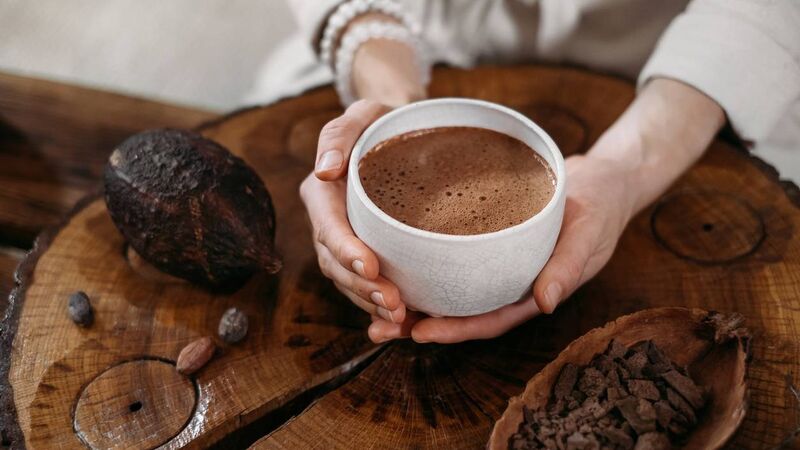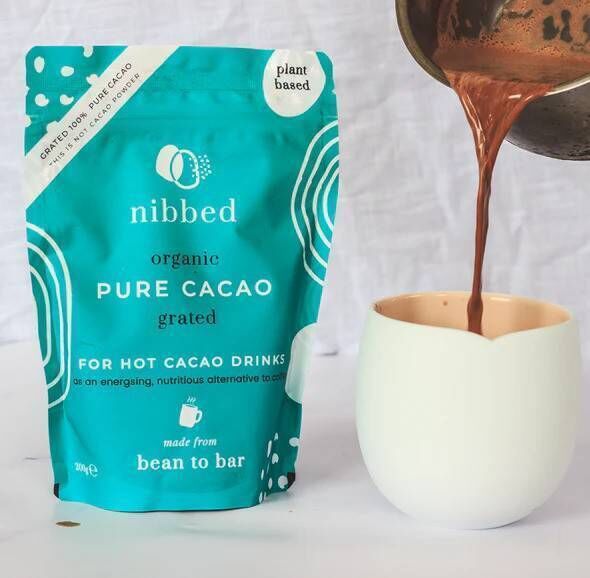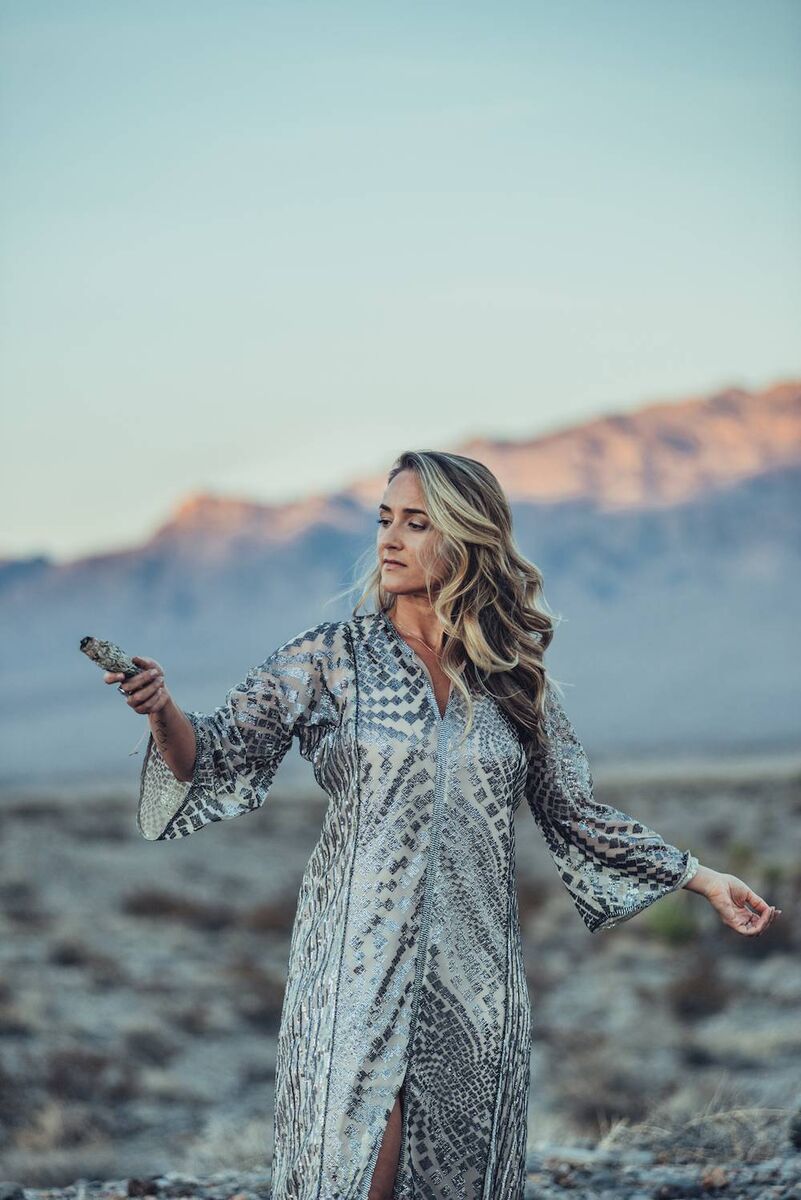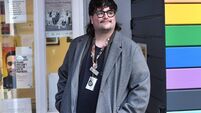I swapped coffee for a cup of cacao — here's what you need to know about the latest wellbeing trend

Cacao is the purest form of cocoa and chocolate.
If you have even a passing interest in wellness, you’ve probably noticed a rich, creamy hot chocolate lookalike popping up on your social media feeds in recent months.
Cacao, the purest form of cocoa and chocolate, has been having a bit of a renaissance — and it seems us Irish can’t get enough of it.
I first came across the so-called superfood at Wellfest in 2023 via a cacao ceremony. The tent was so packed (think Joanne and Vogue at EP levels), us hanger-oners at the back barely got a look-in. A mysterious liquid was being shared with those up the front, and there was a lot of strange shaking going on. Not for me, I thought.
My next experience was at a cacao-infused breathwork workshop. I was there to interview Níall Ó Murchú, also known as @breathewithniall on social media, who was leading the breathing side of things.
His wife Josie, a certified cacao-facilitator, was also in attendance and had brought some cacao with her, which they advised was a perfect pairing for some “blissful breathing”. In the time between my experience at Wellfest in May 2023 and this experience five months later, my awareness of cacao had only increased, and I found myself even more curious as Josie talked about the purported benefits of the plant, which ancient Mayan and Aztec cultures used as a medicine.
As I sipped on this (rather bitter it must be said!) drink, Josie reamed off a list of antioxidants, amino acids and minerals associated with the ingredient including magnesium, tryptophan, flavonoids, dietary fibre and theobromine (more on that one later), before guiding us in a meditative practice.
Afterwards, I felt more calm and, dare I say, at peace, than I had in a long, long time. I was sceptical of how much this had to do with the cacao itself, after all, Josie and Níall had also led us through meditations and a self-love tapping session... but I did feel the drink had somehow aided me in being able to relax and be present in those practices.
“Cacao is a heart medicine,” Josie Uí Mhurchú says, “it helps us drop deep into our heart and get the blood flowing because it’s a vasodilator (medicines that open the blood vessels).
“It contains anandamide, which is a natural bliss-producing chemical and magnesium (associated with having anti-anxiety effects), so it can help us relax and get us into a meditative state.”
I was interested, but the cacao Josie was using retails at €45 per 454g block, and I wasn’t quite willing to take the plunge just yet.
But in the weeks following the event, I seemed to be seeing cacao everywhere. Everyone from Angela Scanlon to Daniella Moyles were drinking it on Instagram stories, and then I came across Nibbed’s Instagram challenge.

The Wicklow-based company has been championing cacao and bean-to-bar chocolate since 2020 and was encouraging customers to try swapping a coffee for a hot cacao, once a day for 10 days.
The brand had also recently added a 200g bag of grated cacao to their product offering which retails at €9.80 — offering you a chance to try it out at a more digestible cost point, and, in a more convenient manner (most cacaos are sold in block form). Consider me sold.
I reached out to co-founder Anna O’Sullivan to see what inspired the challenge.
“We found a lot of people were finding benefits from swapping coffee for cacao.
"Maybe not entirely cutting out their coffee, but cutting down on their caffeine intake,” she says.
It makes sense that Irish consumers might be re-evaluating their relationship with coffee. Research from Bewley’s and Spark Insight in 2021 suggested 78% of Irish adults now drink coffee every day, with most of us consuming an average of three cups per day.
Depending on whether you brew your own coffee at home, or where you purchase it, three coffees (or more) a day could put you beyond The European Food Safety Agency’s guidance, which recommends adults consume no more than 400mg of caffeine a day. To put that in perspective, Nespresso’s original espresso pods contain between 60 and 80mg, but a flat white from Costa contains a startling 277mg per cup.
And, aside from some of the not-so-nice side-effects drinking coffee can bring (the headaches, the crashes...), it might also be a case that consumers are simply looking for their morning cuppa to work harder for them these days. Hence the rise in so-called ‘functional’ coffee brands like DIRTÉA and London Nootropics which contain ingredients such as Lions Mane and Chaga mushrooms.
For Anna, cacao’s star ingredient that makes it the perfect coffee alternative is theobromine.
“It’s a natural stimulant, similar to caffeine, but without the jittery effects,” she explains.
“Theobromine affects the cardiovascular system, whereas caffeine affects the nervous system, hence why many people get anxious and jumpy from drinking coffee.”
While cacao does contain some caffeine, Nibbed’s cacao only contains around 0.22%, for example, which makes it suitable for people like Anna who has never been a big coffee drinker due to the jittery effect it had on her.
I am someone who can easily knock back more cups of tea than you could count on one hand after 4pm, but I do notice the effects of coffee, even after a single cup. In comparison, when I tried swapping out my morning coffee for cacao (admittedly, I am only halfway through my 10 days in a row challenge as I write), I didn’t experience any crashes or unpleasant headaches.
Neither did I experience that tell-tale coffee spike... But, honestly? I saw that as a good thing. As someone prone to anxiety and panic, I found the gentle ‘hum’ of the cacao buzz a lot more welcome as I signed on to work in the mornings than the adrenaline spike of my usual coffee.

What is ceremonial cacao?
Mandalei Kuhn is one of the pioneers of the ceremonial cacao movement in Ireland. She first brought back a few pounds of ceremonial grade cacao in a suitcase home from Peru, and later launched her Magic Earth Cacao brand, which is sourced from the Quechua family in the Cusco Valley, Peru, and the Ruku‘x’Ulew women, an indigenous community in Guatemala. These countries were home to the ancient civilisations who originally cultivated cacao before European colonisation resulted in the start of the commercial chocolate trade.
Kuhn is passionate about ensuring people are aware of the spiritual history of the cacao plant and are aware of the differences between so-called ‘ceremonial grade’ cacao and other cacaos you might find in the health section of your local supermarket.
“Some cacaos don’t come from the origin lands, and may have all of the nutritional benefits,” she acknowledges. But, she says, where ceremonial-grade cacaos are generally sourced from small family farms and hand-processed in the traditional ways, non-ceremonial-grade cacaos may be ultra-processed.
“[Some] of the nutritional benefits go away when it is heated or highly processed,” she says, adding that some products, particularly powdered or nibbed varieties, may use a variety of beans and types of cacao.
“There are three beans, ceremonial cacao is usually from the Criollo plant which has the highest level of antioxidants and nutrients. When you’re buying cheaper cacao from commercial shops, they’re likely not using the Criollo plant, or they’re using a mix.”
These cacaos may still retain the health benefits, but for those looking to engage in a spiritual practice, Kuhn says they can’t be considered for use in ceremony.
And what is a cacao ceremony, I hear you ask? Well, it’s essentially where a lot of people gather together to drink cacao, and may do it alongside meditation, sound healing, or other wellness practices. Some people claim to have intense healing experiences during these ceremonies. A few people I spoke to after my own session with Josie Uí Mhurchú said they had become emotional during the experience or felt teary. TV presenter Angela Scanlon admitted on her podcast she “wept like a baby” after having a cup of it.
I admitted to Kuhn that while I might have noticed a difference in taste between ceremonial and non-ceremonial cacaos (I tried both researching this piece), I didn’t have any sort of spiritual reaction to it.
Though, the ritual of taking some time for myself in the morning to make the cacao and sit down and journal and/or meditate while drinking it did feel special.
“You know, I would say that’s a spiritual experience there in itself. I lived in Dublin for 11 years [she now lives in Portugal] and I was a lawyer.
"I was working in the corporate world, almost all of my friends were, and we were all burnt out."
"We were all starting our mornings, rushing out the door, getting a coffee on the go, to make that time in the morning to slow down, to make your cacao drink, you’re actually connecting with what you’re making, you’re not having someone else serve it to you, you are putting your intention into those quiet moments. You are taking that time for yourself. To me, that is a spiritual experience. You’re taking that time to connect to your body, to connect to yourself.”
“I see ceremonial cacao as a traditional plant medicine for modern times,” she says. “Rituals are essential to human beings, psychologically, emotionally and spiritually. And ceremonial cacao is an excellent tool to open our hearts to healing, love, abundance and creativity.”

Nicole's cacao recipe
Ingredients
3 tablespoons of cacao shavings
(approx 30g)
250ml oat milk
1 tsp cinnamon
1 tsp vanilla essence
Method
Add all the ingredients to a saucepan – be careful not to let it boil. Continuously whisk until the cacao shavings are fully melted. Pour and enjoy.
CONNECT WITH US TODAY
Be the first to know the latest news and updates

Celebrating 25 years of health and wellbeing










